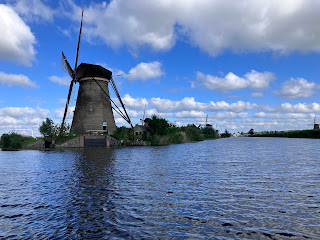June 19th. Weather fine and blue sky but still quite chilly wind
After another buffet breakfast we all boarded the coach and drove through Rotterdam on to the motorway system toward the famous windmills.
The guide played a DVD telling the story of how after a great flood back in the 1700s it is said that rescuers found a cat ‘dancing’ on top of a cradle and by that side to side movement kept the cradle stable and saved the life of the baby. Myth or truth no one now knows but from that time windmills were used to drain the excess water from the land into the rivers and so began a fight with the sea. And because of the story of the child’s life saved this area is now called Kinderdijk.
Once the coach was parked we walked a short distance to the boat which was to take us on the 90 minute cruise up the river to see the famous windmills. For this we had a local guide Liam. A very personable young man he told us his father was from North Yorkshire and his mother was Dutch which probably explained why his accent was such a mixture.
Initially we cruised silently (the boat has an electric motor) past houses which looked quite valuable and each had a private jetty/dock and a boat. One particularly expensive looking place also had a robot lawn mower keeping the green velvet grass immaculate.
Then we all spied our first windmill. This one was not within the UNESCO World Heritage site and indeed was quite ‘young’ having been only built in 1840 but it generated a lot of interest among the group.
Further along there was the line of windmills.
Our guide/captain told us that to be able to live there one must first spend two years at Windmiller School and then put one’s name down on the waiting list for a vacancy which is currently 14 years. Then for a rental of €300 per month one can live there on an indefinite rental agreement and on the condition that the windmill sails are rotated at least 60,000 times a year. Apparently most of the people also have other work so during the week days it is unusual to see a windmill operating. Today one in the distance was in full sail but the others were still and in the + position which seems to be neutral. If the top sail is in the 11o’clock position it signifies mourning, if the top sail is in the 1 o’clock position it signifies some happy occasion such as a wedding or a birth and if the sail is in the X position that is the signal for an emergency. Today, apart from the working mill all were in the stationery + position. One windmill is open as a museum and is considered non-working. We saw the miller there, in his clogs, putting the sheets on the sails but a visit to that museum was not included with our tour.
All too soon we turned
and went back to the dock and then on the coach for the one and a half hours drive to Arnhem.
At Arnhem we had around 90 minutes of free time and lunch and I found that my credit card would not work to buy my lunch but worked fine when I needed the toilet. The last time I remember paying to use a public toilet is well over 60 years ago and it was Penny then! Today was 50 European Cents.
Our coach returned and took us to Oosterbeek to the War Cemetery. 1764 young soldiers are buried there, tragic victims of Operation Market Garden and the failure of the Battle of Arnhem.
I was surprised at how many of the headstones were for An Unknown Soldier. Obviously many of the remains were not identified but have been acknowledged by the Commonwealth War Graves Commission who are responsible for the excellent upkeep of this cemetery.
I hadn’t heard much about this but for the Dutch this horrific event of WWII is remembered well and our guide was anxious that we should all visit. She also acknowledged that it was the Canadian Forces who liberated The Netherlands and the Canadians on our tour had a particularly poignant reminder of their countrymen.
Very close by was the Hartenstein Museum to which we drove next.
This is a mansion that served as the HQ of the British First Airborne Division which attempted unsuccessfully to form a bridgehead on the northern banks of the Rhine River. General John Frost did manage to hold the position for four days but in the end it was an unsuccessful operation. If I understood correctly Operation Market (airborne forces) Garden (land forces) was an unsuccessful adaptation of a plan originally the brainchild of Field Marshal Montgomery. Although this museum has, according to our guide, an excellent reputation I found it incoherent and the guidance as to sequence of the audio visual self guide was inadequate. So I didn’t enjoy the experience and opted not to go to the basement level where there is a simulation of the actual battle. Instead I sat with a Black Pepsi in the gardens at the rear and waited with others for the group to reassemble. Yes, today I learnt what a Black Pepsi is = zero sugar. And my credit card worked at the little pie cart cafe!
Tonight we are staying in another Bildeberg hotel in the Oosterbeek Park and we have dinner included so no more decisions are necessary. My room is small but adequate and clean and I intend to sleep well! This package tour travelling is tiring.
















1 comment:
I knew about the famour windmills of course, but I learned so much more about them today. How Interesting! Two years of school to operate one of those? I wonder what they are taught...
Post a Comment